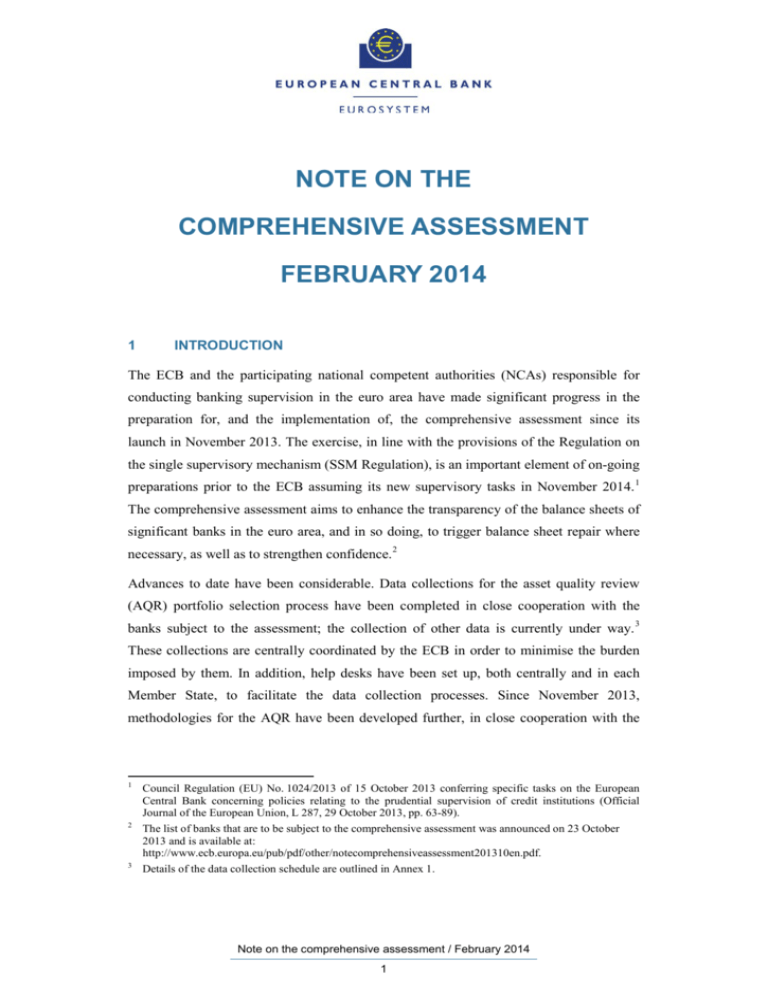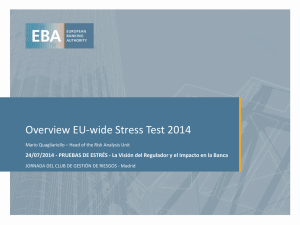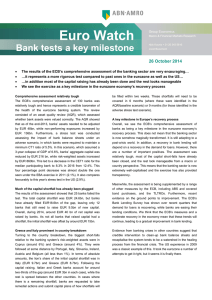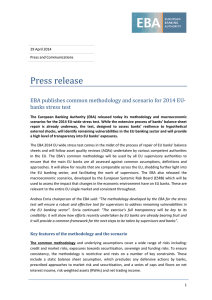Note on the Comprehensive Assessment, February 2014
advertisement

NOTE ON THE COMPREHENSIVE ASSESSMENT FEBRUARY 2014 1 INTRODUCTION The ECB and the participating national competent authorities (NCAs) responsible for conducting banking supervision in the euro area have made significant progress in the preparation for, and the implementation of, the comprehensive assessment since its launch in November 2013. The exercise, in line with the provisions of the Regulation on the single supervisory mechanism (SSM Regulation), is an important element of on-going preparations prior to the ECB assuming its new supervisory tasks in November 2014. 1 The comprehensive assessment aims to enhance the transparency of the balance sheets of significant banks in the euro area, and in so doing, to trigger balance sheet repair where necessary, as well as to strengthen confidence. 2 Advances to date have been considerable. Data collections for the asset quality review (AQR) portfolio selection process have been completed in close cooperation with the banks subject to the assessment; the collection of other data is currently under way. 3 These collections are centrally coordinated by the ECB in order to minimise the burden imposed by them. In addition, help desks have been set up, both centrally and in each Member State, to facilitate the data collection processes. Since November 2013, methodologies for the AQR have been developed further, in close cooperation with the 1 2 3 Council Regulation (EU) No. 1024/2013 of 15 October 2013 conferring specific tasks on the European Central Bank concerning policies relating to the prudential supervision of credit institutions (Official Journal of the European Union, L 287, 29 October 2013, pp. 63-89). The list of banks that are to be subject to the comprehensive assessment was announced on 23 October 2013 and is available at: http://www.ecb.europa.eu/pub/pdf/other/notecomprehensiveassessment201310en.pdf. Details of the data collection schedule are outlined in Annex 1. Note on the comprehensive assessment / February 2014 1 NCAs. The ECB has also worked closely with the European Banking Authority (EBA) on the development of the stress test methodology. In addition to these advances, mobilisation for the comprehensive assessment has taken place across the euro area. National steering committees and project management offices have been established and staffed by all participating Member States, mirroring the structures established centrally at the ECB, to ensure the smooth functioning and continuous monitoring of all elements of the assessment. NCAs have also advanced in their procurement of the necessary third-party support, to ensure that it is in place in good time. This note provides an overview of the recently agreed key building blocks of the stress test, an outline of the progress made to date on the AQR, more details of the AQR methodology and a high-level summary of the approach with respect to quality assurance for the comprehensive assessment. 2 STRESS TEST The EBA announced the key features of the forthcoming EU-wide stress test exercise last week. 4 For the stress test component of the comprehensive assessment, the ECB will cooperate closely with the EBA, and will apply the methodology and parameters agreed and announced by that authority. In the context of the comprehensive assessment, the stress test for the SSM countries will, in addition, incorporate the results of the on-going AQR. The ECB comprehensive assessment, including the stress test, will be conducted at the level of banks deemed significant under the SSM, which includes subsidiaries in some cases. 5 The comprehensive assessment will be carried out for 128 credit institutions, including a number of significant subsidiaries of euro area and non-euro area banking groups. The EU-wide EBA exercise will be conducted at the highest level of consolidation for a given banking group and, therefore, for a smaller sub-sample of banks than the 4 5 European Banking Authority, ‘Main features of the 2014 EU-wide stress test’, 31 January 2014. Significant in this context is defined according to the criteria outlined in the annex “Methodology for identifying the institutions subject to the comprehensive assessment” (available at: http://www.ecb.europa.eu/pub/pdf/other/notecomprehensiveassessment201310en.pdf). The EBA has announced that its stress test sample will include the majority of the euro area banks included in the comprehensive assessment sample. For those not included – the subsidiaries – the stress test, using the same methodology and parameters, will be conducted as part of the comprehensive assessment. Note on the comprehensive assessment / February 2014 2 comprehensive assessment. The ECB stress test component of the comprehensive assessment, for the remainder of the 128 banks that are subject to the assessment, will follow the approach agreed with the EBA. Commonly agreed EU-wide baseline and adverse scenarios will be developed by the European Systemic Risk Board (ESRB), in close collaboration with the ECB and the EBA, as in previous exercises. The adverse scenario will capture the prevailing view of current risks facing the financial system in Europe. The horizon for the exercise will be three years – December 2013 to December 2016 – and details of the scenarios will be made available once finalised at the end of April 2014. The capital adequacy threshold for the baseline scenario will be 8% Common Equity Tier 1 (CET1) capital, whereas – as communicated by the EBA – a threshold of 5.5% CET1 will apply in the case of the adverse scenario. The baseline threshold is identical to the minimum threshold being applied in the AQR. If a bank’s capital falls below the predefined threshold at the end of the stress test horizon, remedial action must be taken. The definition of CET1 capital used for the stress test will be that applicable at the end of the horizon on 31 December 2016. In the stress test, any capital shortfall arising from either the baseline or the adverse scenario relative to agreed benchmarks will require a strengthening of capital buffers and/or other supervisory interventions, as will losses ascertained in the AQR. As the stress test results for the banks that are subject to the comprehensive assessment will incorporate capital requirements that may result from the AQR, the end result will be more demanding than in previous exercises. The time frame within which the strengthening of capital buffers must take place will depend on the respective outcome: a shortfall relative to the baseline scenario will require that capital be raised in the nearer term, whereas a shortfall arising from the adverse scenario may only require capital to be raised over a more extended period, on the basis of an agreed capital plan, so long as regulatory minima are respected. That capital plan will also depend on when, over the course of the stress test horizon, a shortfall may arise. Besides CET1 capital instruments, additional capital instruments entailing a mandatory conversion into CET1 capital may be eligible for use to address a capital shortfall arising from the adverse stress test scenario, as long as the conversion trigger is set at 5.5% or above. Only instruments with unconditional contract clauses relating to such conversion will be eligible. Note on the comprehensive assessment / February 2014 3 For reasons of simplicity, consistency and comparability, the EBA stress test exercise will be carried out on the basis of a static balance sheet assumption. This implies, inter alia, a zero growth of bank balance sheets and an unchanged maturity profile of the respective bank’s assets and liabilities. Additionally, the ECB may complement the static approach with an analysis of the evolution of credit under the scenarios. The static balance sheet assumption may be set aside where mandatory restructuring plans have been publicly announced before 31 December 2013 and have been formally agreed with the European Commission before the conclusion of the comprehensive assessment. The approach to quality assurance for the banks subject to the comprehensive assessment (see Section 5 below) will also be used for the stress test. The ECB, as the incoming competent authority for the sample of significant banks that are to be subject to the comprehensive assessment, will be responsible for stress test quality assurance. The structures established and the resources available for conducting the assessment will be fully utilised to ensure the maximum consistency and comparability of not only the AQR, but also the stress test. The exercise will fully respect the provisions laid down in the applicable accounting frameworks – be they the International Financial Reporting Standards (IFRSs) or generally accepted national accounting practices (national GAAPs) – and those set out in the CRR/CRD IV. For the stress test, Pillar 2 decisions may be used to go beyond regulatory minima. The stress test will cover credit, market, funding and securitisation risks. As announced by the EBA, sovereign exposures in held-to-maturity portfolios will be treated in the same way as other credit exposures in that portfolio, i.e., the impact of the scenarios on the default and loss parameters will be calculated and will result in larger provisions. Sovereign exposures in the available-for-sale and held-for-trading portfolios will be marked-to-market, in line with the scenarios employed. The CRR/CRD IV allows for the gradual phasing-out of available-for-sale prudential filters on sovereign exposures over a transitional period. The effects of these filters will, nevertheless, be fully disclosed with the results of the comprehensive assessment, so that market participants can understand the implications of these filters. In addition, banks’ holdings of sovereign exposures, and their respective maturities, will be disclosed in full. Note on the comprehensive assessment / February 2014 4 3 ASSET QUALITY REVIEW – PROGRESS REPORT In addition to the progress made in finalising the AQR methodology and agreeing on the parameters of the stress test, headway has been made on a number of related fronts, in particular with respect to the mobilisation of national competent authorities for the exercise and the conduct of phase 1 of the AQR, portfolio selection. Each NCA has set up a national steering committee and a project management office, mirroring the structures established centrally at the ECB. The national steering committees will oversee and monitor the comprehensive assessment at the national level, and will be responsible for the timely delivery of key outputs to the ECB. National project management offices will control, coordinate and promote the execution of the comprehensive assessment, outlining detailed project plans, tracking whether milestones have been reached and reporting the project status to both national steering committees and the ECB. Quality assurance and technical assistance teams, and bank inspection teams, are currently being set up, in order to be fully mobilised for the execution of the AQR. The ECB is fully committed to effective information-sharing between home and host country supervisory authorities, both in the EU and beyond. With respect to the selection of portfolios – AQR phase 1 – data for all 128 banks were submitted to the ECB on schedule in late December, followed by a data quality review undertaken in close cooperation with the NCAs. The collection of data focused on identifying the most risky portfolios for inclusion in the AQR and subject to the minimum criteria that selected portfolios must account for at least 50% of a bank’s risk-weighted assets. Intensive work is currently under way to select, bank-by-bank, the portfolios to be reviewed. That process will end in mid-February. 4 ASSET QUALITY REVIEW – METHODOLOGY Working in close cooperation with the participating NCAs, considerable advances have been made on the AQR methodology. This methodology will be finalised in the coming weeks and will be published in the first quarter of 2014. It should be borne in mind that the AQR is being conducted in three phases: 1) the currently on-going portfolio selection, to focus the exercise on the most risky portfolios in bank’s balance sheets, which will end in February; 2) execution, i.e., the actual review of the assets, collateral and provisioning in the selected portfolios and level-3 fair-value assets, which will commence in March Note on the comprehensive assessment / February 2014 5 and will be preceded by the collection of data and data integrity validation; and 3) quality assurance and reporting of results in October 2014. The first steps in the second phase of AQR execution will be undertaken in February, with the initial focus on the review of policies and procedures, and on the preparation of so-called loan tapes. Building on the approach approved in October 2013, the methodology for carrying out the AQR will comprise a number of distinct building blocks. Together, these blocks will provide a coherent, consistent and comprehensive approach to reviewing the asset quality of the selected portfolios of participating banks. Figure 1 below provides a schematic overview of these building blocks, which can be grouped as follows. Figure 1: Schematic overview of the AQR methodology Review of banking book exposures Review of processes, policies and accounting Loan tape creation and data integrity validation Projection of findings of credit file reviews Sampling of credit files Credit file reviews Collective provision analysis Collateral and real estate valuations Review of level-3 fair-value exposures Revaluation of non-derivative level-3 assets Review of core trading book processes Review of level3 derivative pricing model Quality assurance Preparations and data – processes, policies and accounting reviews, loan tape creation, data integrity validation and sampling can be characterised as preparatory steps for the execution of the AQR. Each of these building blocks is interlinked and creates the foundations on which the remainder of the exercise will rest. The review of processes, policies and accounting practices is the first step in the exercise, providing information on the impact of policies and processes on the book values of assets on banks’ balance sheets. While this review of processes and policies is important, Note on the comprehensive assessment / February 2014 6 it will be a “bare minimum” approach, so that the remaining steps are duly informed, while avoiding any significant overlap with the Supervisory Risk Assessment. The analysis of credit exposures will be based on loan tapes. These consist of granular, credit exposure-level information drawn from banks internal information systems. The loan tapes include basic account information, such as segment classification, status, identifiers of the loan-entity, and will be collected for at least all selected portfolios. Banks will be responsible for the collection of these data, in close cooperation with NCAs. The latter will be responsible for liaising with banks to ensure that the collected data are of the required quality and are submitted in good time. The collection will commence as from mid-February, although the required templates have already been subject to two rounds of testing by the banks and NCAs to ensure their optimisation. The collection of these tapes, and the subsequent data integrity validation processes mark an early step in the AQR. Data integrity validation will ensure that the data is of sufficient quality to carry out analysis in subsequent steps. These processes are fundamental for the later steps of sampling, credit file reviews and collective provisioning analysis, as they are all influenced by the availability of sufficient, good-quality data. Consequently, every effort undertaken on preparing and ensuring data quality will be of benefit in terms of efficiencies in both time and resources during subsequent steps. For relevant portfolios, sampling will allow credit file reviews to be carried out without requiring all exposures in a portfolio to be reviewed. The approach to sampling will ensure that the sample is sufficiently representative to deliver robust analytical results. File review, provision analysis and appraisals – reviews of banking book exposures will be a central element of the AQR process. For the credit file reviews, NCA bank-level teams, working closely with independent third parties, and building on the three steps outlined earlier, will verify that credit exposures have been correctly classified and that, if a specific provision is required, it has been set at an appropriate level. For homogeneous pools of exposures, the findings of credit file reviews will be projected to the wider portfolio. This means that the risk weights of these portfolios will be changed for use in the stress test. The assessment will not, however, review internal models used by banks for the calculation of risk-weighted assets, given the limited time available to complete the exercise. Collateral and real estate valuations determine, in part, the appropriate book values for collateral or on-balance-sheet real estate assets and will provide a direct input to credit Note on the comprehensive assessment / February 2014 7 file reviews. Collateral and real estate valuation will be carried out by the NCA bank inspection teams, working closely with independent third-party specialists, for the relevant samples. Finally, a review of collective provision approaches will be undertaken for sub-portfolios of small-scale, homogeneous exposures, to ensure their full alignment with accounting rules. The exercise will use a definition of non-performing exposures that has been agreed with the EBA, which means that every material exposure 90 days past due will be classified as non-performing even if not recognised as defaulted or impaired. Review of level-3 fair-value exposures – this will commence once the review of processes, policies and accounting practices has been completed, and will thus be undertaken in parallel with the review of banking book exposures. This building block will only be used for banks with material level-3 exposures. The review of level-3 fairvalue exposures includes an AQR of the trading book, applied to banks with material trading books. 6 For banks with material level-3 banking or trading book exposures, a revaluation of the most important securities will be performed. For banks with the most important trading books, an AQR review of the trading book will be conducted, consisting of a qualitative review of core trading book processes, combined with a quantitative review of the most important derivative pricing models. 5 QUALITY ASSURANCE Quality assurance processes have been designed for the comprehensive assessment to ensure a high quality and the timely delivery of the assessment, in a standardised manner, across all significant banks. For the purposes of the AQR, quality assurance will be performed by the NCAs and the ECB. The structures that have been put in place at the central and local level will facilitate the quality assurance process and will result in layers of assurance being built up throughout the exercise. At the bank level, inspection teams will carry out analysis to mandatory standards, while national quality assurance teams will review and oversee this work in terms of quality and accuracy. The ECB will provide system-wide quality assurance, through its own quality assurance processes and through the deployment of teams to participate in and oversee local bank inspections. 6 Annex 2 provides an overview of the methodology applied to select the banks for which the AQR trading book review will be performed. Annex 3 provides the list of banks for which the AQR trading book review will be conducted. Note on the comprehensive assessment / February 2014 8 For the stress test, quality assurance will comprise a number of elements. Bottom-up stress test results submitted by banks will be subject to in-depth analysis and challenge processes. This will include data consistency checks, portfolio-level, country-level and aggregate comparative analysis, and thorough qualitative checks on model inputs and assumptions. Further cross-checks will be conducted through a top-down stress test. This will provide both benchmark parameters and a basis for cross-checking the bottom-up results. 6 STEPS AHEAD The ECB will continue to work closely with the NCAs in order to finalise the AQR methodology and, in parallel, the process of portfolio selection will be concluded in February. The methodology will be published in the first quarter of 2014. The AQR’s execution phase will then commence with the deployment of teams of bank inspectors for the conduct of credit file reviews and other necessary activities. The ECB will also deploy teams to oversee these processes in each country. Over the coming weeks, further data collections will be launched, as detailed in Annex 1. The structures that have been put in place both centrally and nationally will continue to evolve so as to meet the needs of the execution phase of the AQR, which will see the formation of bank inspection teams, quality assurance and technical assistance teams, and the cross-participation of bank supervisors from other euro area countries. The engagement of third parties will be finalised in all countries and appropriate training possibilities will be put in place to ensure the consistent application of the methodological manual. In parallel, the development of the scenarios for use in the stress test will continue and they will be made available at the end of April. Before assuming its supervisory tasks in November 2014, the ECB will publish detailed results of the comprehensive assessment, as well as any recommendations relating to individual banks. Note on the comprehensive assessment / February 2014 9 Annex 1 Timeline for further data collections AQR trading book review deadline for submission of data to the ECB 7 Feb. deadline for comments on first field test 7 Jan. deadline for comments on second field test 27 Jan. loan tape collection launched 14 Feb. deadline for completion of loan tapes 14 Mar. Loan tapes Note on the comprehensive assessment / February 2014 10 Annex 2 Methodology for the selection of the institutions included in the AQR of the trading book The AQR will include a quantitative and qualitative review of hard-to-value assets, particularly those qualifying as level-3 assets. It should be noted that level-3 assets will be included in the AQR irrespective of whether banks hold these assets in the banking book or the trading book. 7 The general review of level-3 fair-value exposures will apply to each bank subject to the comprehensive assessment that holds a material exposure of hard-to-value assets. In addition, the ECB has identified banks with material trading book exposures that will be subject to a more specifically tailored AQR of the trading book. This will be an in-depth review and will not only focus on non-derivative level-3 exposures, but will also include a review of both level-3 derivative pricing models and core trading book processes. The method for the selection of banks included in the AQR trading book review has been designed to focus on banks where the mis-statement of fair values could have to a material impact on the Common Equity Tier 1 capital ratio. The ECB identified these banks on the basis of a broad range of data: both publicly available information and supervisory proprietary information. The methodology applied for the selection includes absolute and relative criteria. More specifically, the selection of banks was based on indicators that take into account the absolute volume of the overall trading book and the level-3 financial instruments in the trading book. This information was complemented by indicators that consider the relative magnitude of the relevant trading business in comparison with total assets and other relevant risk metrics. The result was scrutinised and supplemented by expert judgement so as to obtain a balanced and comprehensive list of banks for the AQR trading book review, in agreement with relevant NCAs. 7 Where appropriate, this will also include the respective liabilities. An under-valued trading book liability is equivalent to an over-valued trading book asset. Note on the comprehensive assessment / February 2014 11 Annex 3 List of banks to be included in the AQR trading book review Belgium Belfius Banque SA Dexia NV 8 KBC Group NV Finland Nordea Bank Finland Abp BNP Paribas Groupe BPCE France Groupe Crédit Agricole Groupe Crédit Mutuel HSBC France Société Générale Bayerische Landesbank Commerzbank AG DekaBank Deutsche Girozentrale Germany Deutsche Bank AG DZ Bank AG Deutsche Zentral-Genossenschaftsbank HSH Nordbank AG Hypo Real Estate Holding AG Landesbank Baden-Württemberg Landesbank Hessen-Thüringen Girozentrale Ireland Merrill Lynch International Bank Limited Banca Monte dei Paschi di Siena S.p.A. Italy Intesa Sanpaolo S.p.A. Mediobanca - Banca di Credito Finanziario S.p.A. UniCredit S.p.A. Netherlands Coöperatieve Centrale Raiffeisen-Boerenleenbank B.A. ING Bank N.V. The Royal Bank of Scotland N.V. Spain 8 Banco Bilbao Vizcaya Argentaria, S.A. Banco Santander, S.A. The assessment methodology for this group will duly take into account its specific situation and, in particular, the fact that an extensive assessment of its financial position and risk profile has already been carried out within the framework of the plan initiated in October 2011 and approved by the European Commission on 28 December 2012. Note on the comprehensive assessment / February 2014 12








